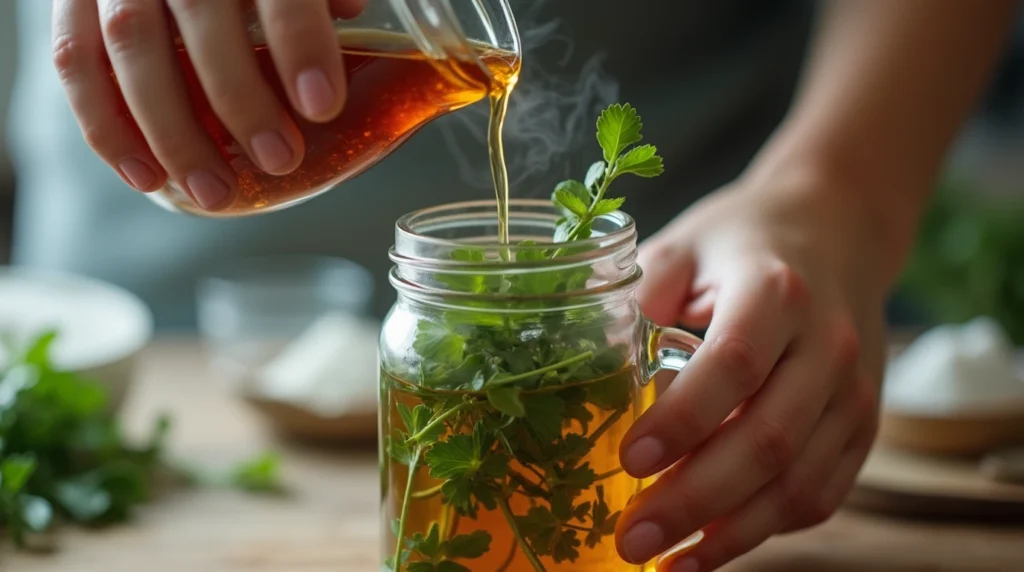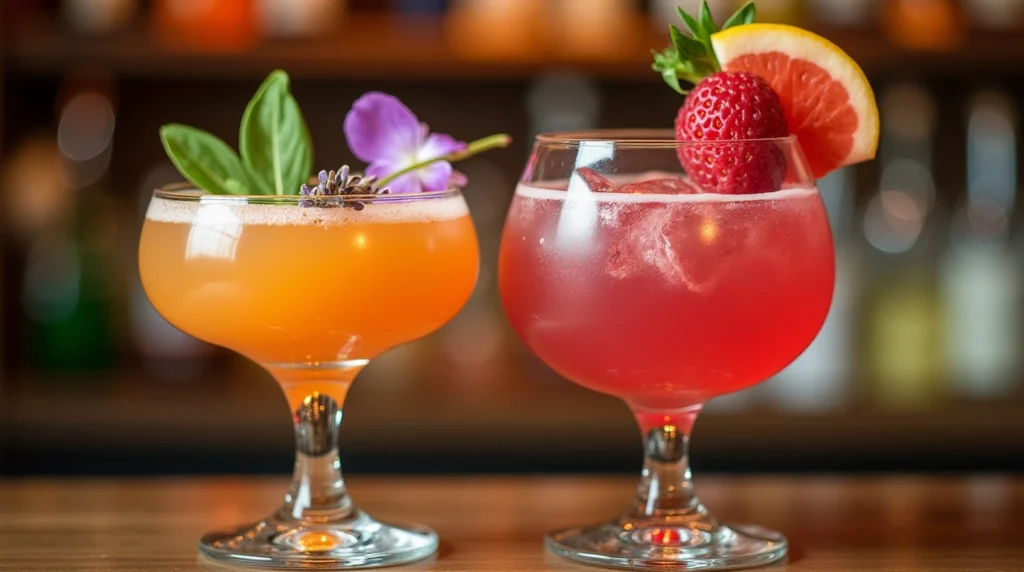Herbal Cordial Recipe: Hey there, health enthusiasts and kitchen adventurers! Ever wondered how to turn your garden’s bounty into a delightfully delicious and surprisingly healthy drink? Well, buckle up, because we’re diving headfirst into the wonderful world of herbal cordial recipes. Think of it as alchemy, but with herbs, sugar (or honey!), and a whole lot of flavor.
Forget those sugary sodas and artificial juices. We’re talking about crafting elixirs that not only tantalize your taste buds but also pack a punch of natural goodness. Imagine sipping a cool, refreshing drink on a hot summer day, knowing that every sip is boosting your immune system, soothing your digestion, or helping you unwind after a long day. Sounds good, right?
This guide is your passport to becoming a cordial connoisseur. We’ll explore the rich history of these botanical beverages, uncover their amazing health benefits, walk you through a classic herbal cordial recipe step-by-step, and even inspire you with creative variations. Plus, we’ll tackle those pesky problems that can sometimes pop up during the cordial-making process, ensuring your success from start to finish. So, grab your apron, gather your herbs, and let’s get started!
Table of contents
- What is Herbal Cordial Recipe? Unlocking the History and Health Benefits
- Gathering Your Ingredients: The Herbalist’s Pantry for Cordials
- Herbal Cordial Recipe: Step-by-Step Guide to a Classic Elixir
- Beyond the Basics: Creative Herbal Cordial Recipe Variations
- Troubleshooting Common Cordial-Making Problems
- Herbal Cordial Recipe Cocktails: Elevating Your Mixology Game
- Legality and Safety: Important Considerations for Herbal Cordial Recipe
- Herbal Cordial Recipe: Frequently Asked Questions (FAQs)
- Conclusion: Embrace the Art of Herbal Cordial Recipe Making
What is Herbal Cordial Recipe? Unlocking the History and Health Benefits
Before we get our hands dirty (or should I say, sticky with syrup?), let’s define what we’re talking about. What exactly is an herbal cordial? Simply put, it’s a sweet, non-alcoholic syrup infused with the flavors and medicinal properties of herbs. Traditionally, cordials were alcoholic, but the modern interpretation often focuses on creating a healthier, alcohol-free alternative that’s perfect for everyone.
A Brief History of Herbal Cordial Recipe: From Apothecary to Your Kitchen
The history of cordials is fascinating! Back in the day, they weren’t just tasty drinks; they were considered essential medicine. Monks and apothecaries concocted potent herbal remedies, often using alcohol as a preservative and to extract the beneficial compounds from the plants. These early cordials were used to treat everything from digestive issues to the common cold.
“In the old days, a cordial was as much a part of the medicine cabinet as it was the pantry. People relied on these herbal infusions for both pleasure and healing.”
As time went on, cordials evolved from purely medicinal concoctions to more recreational beverages. They became popular in taverns and homes, enjoyed as a sweet treat or a digestif after a meal. Today, we’re seeing a resurgence of interest in herbal cordials, as people seek out natural and flavorful alternatives to mass-produced sodas and juices.
The Health Benefits of Herbal Cordial Recipe: Beyond Just a Sweet Treat
Okay, let’s get down to the good stuff. Besides being incredibly delicious, herbal cordials offer a wide range of potential health benefits, depending on the herbs you use. Remember, I’m not a doctor, so this isn’t medical advice, but here are a few examples:
- Digestive Support: Herbs like ginger, peppermint, and chamomile can help soothe the stomach, relieve bloating, and promote healthy digestion.
- Immune Boosting: Elderberry, echinacea, and rosehips are packed with antioxidants and vitamins that can help strengthen your immune system and fight off infections.
- Relaxation and Stress Relief: Lavender, lemon balm, and passionflower have calming properties that can help reduce stress, promote relaxation, and improve sleep.
Of course, it’s important to remember that herbal cordials are not a magic bullet. They’re best used as part of a healthy lifestyle that includes a balanced diet, regular exercise, and plenty of rest. But adding a delicious and beneficial herbal cordial to your routine can be a fun and flavorful way to support your overall well-being. And who doesn’t want a little extra boost from nature’s pharmacy?
Gathering Your Ingredients: The Herbalist’s Pantry for Cordials
Ready to raid your garden (or the farmer’s market)? The beauty of herbal cordial recipes is that you can customize them to your own tastes and needs. But before you start, let’s talk about the essential ingredients you’ll need.
Essential Equipment for Cordial Making: What You’ll Need
You don’t need a fancy laboratory to make herbal cordials, but a few key pieces of equipment will make the process easier and more enjoyable:
- Saucepan: For making the base syrup.
- Measuring Cups and Spoons: Accuracy is key!
- Glass Jars or Bottles: For infusing the herbs and storing the finished cordial.
- Fine-Mesh Strainer or Cheesecloth: For filtering out the herbs.
- Funnel: For easy bottling.
- Optional: Thermometer: For precise temperature control.
Choosing Your Herbs: From Garden to Glass
This is where the fun really begins! The possibilities are endless when it comes to choosing herbs for your herbal cordial. You can use fresh herbs from your garden, dried herbs from the store, or even a combination of both. Just make sure you’re using high-quality ingredients for the best flavor and health benefits.
Popular Herbs for Cordials: Flavors and Benefits
Let’s explore some popular herb choices for cordials and their benefits:
For Digestive Health: Ginger, Peppermint, Chamomile
Ginger adds a spicy kick and aids digestion. Peppermint soothes the stomach and refreshes the palate. Chamomile calms the nerves and promotes relaxation, making it a great addition to a bedtime cordial.
For Immune Support: Elderberry, Echinacea, Rosehips
Elderberry is a well-known immune booster, packed with antioxidants and antiviral properties. Echinacea is another powerful immune stimulant that can help fight off colds and flu. Rosehips are rich in vitamin C and other nutrients that support overall health.
For Relaxation: Lavender, Lemon Balm, Passionflower
Lavender adds a floral aroma and promotes relaxation. Lemon balm is known for its calming and uplifting properties. Passionflower is a natural sedative that can help reduce anxiety and improve sleep.
Remember to research each herb before using it, especially if you have any underlying health conditions or are taking medications. Some herbs can interact with certain drugs, so it’s always best to err on the side of caution.
Herbal Cordial Recipe: Step-by-Step Guide to a Classic Elixir
Alright, let’s get to the herbal cordial recipe itself! This is a basic recipe that you can easily adapt to your own tastes and preferences. I suggest starting here and branching out to your own creations!
Ingredients:
- 1 cup water
- 1 cup sugar (or honey, maple syrup, agave nectar – your choice!)
- 1 cup fresh herbs (or 1/2 cup dried herbs) – use one type or mix and match
- Optional: 1 tablespoon lemon juice (acts as a preservative and adds brightness)
Instructions:
Base Syrup Preparation: The Foundation of Your Cordial
- Combine water and sugar (or your chosen sweetener) in a saucepan.
- Heat over medium heat, stirring constantly, until the sugar is completely dissolved.
- Bring to a simmer and cook for 1-2 minutes.
- Remove from heat.
Infusion Methods: Hot vs. Cold – Which is Best?
Now comes the herb infusion! You have two main options: hot infusion and cold infusion.
- Hot Infusion: Add the herbs to the hot syrup, stir well, and let steep for at least 30 minutes (or up to several hours) until the syrup has reached your desired level of flavor and potency.
- Cold Infusion: Add the herbs to the syrup and store in a sealed jar in the refrigerator for 24-48 hours. This method is gentler and can preserve more of the delicate flavors and aromas of the herbs.
Which method is best? It depends on the herbs you’re using and your personal preference. Delicate herbs like lavender and chamomile are best infused using the cold method, while tougher herbs like ginger and rosemary can withstand the heat of a hot infusion.
Combining Herbs and Syrup: A Delicate Balance
The exact amounts can be adjusted to your own taste, so feel free to experiment here.
Bottling and Storage: Preserving Your Herbal Treasure
- Strain the syrup through a fine-mesh strainer or cheesecloth to remove the herbs.
- Add the lemon juice (if using) and stir well.
- Pour the cordial into sterilized glass bottles or jars.
- Seal tightly and store in the refrigerator.
With proper storage, your homemade herbal cordial recipe will last for several weeks (or even months) in the refrigerator. But let’s be honest, it probably won’t last that long!
“The magic of herbal cordials lies in their ability to transform simple ingredients into something truly special. It’s a way to connect with nature, nourish your body, and delight your senses.”

Beyond the Basics: Creative Herbal Cordial Recipe Variations
Now that you’ve mastered the basic herbal cordial recipe, it’s time to get creative! The possibilities are truly endless. Think about your favorite flavors, the herbs growing in your garden, and the health benefits you’re seeking. Here are a few ideas to get you started:
Fruity Flavors: Blending Herbs with Berries and Stone Fruits
Adding fruits to your herbal cordial recipe can create a delightful blend of flavors and boost the nutritional value. Consider these combinations:
- Raspberry & Rose: The tartness of raspberries complements the floral aroma of rose petals.
- Peach & Basil: The sweetness of peaches pairs perfectly with the savory notes of basil.
- Blackberry & Mint: A classic combination that’s both refreshing and antioxidant-rich.
- Cherry & Almond: A sophisticated blend perfect for drizzling over desserts or adding to cocktails.
To incorporate fruit, simply add it to the saucepan along with the water and sugar when making the base syrup. Mash the fruit slightly to release its juices and then strain the syrup through a fine-mesh strainer or cheesecloth to remove the pulp. You can also add fruit juice to the already made cordial, just be sure to adjust your water levels!
Spicy Cordials: Adding Warmth and Zest to Your Drinks
For those who like a little kick, spicy herbal cordials are the way to go. Think warming spices like cinnamon, cloves, cardamom, and ginger. Here are some ideas:
- Cinnamon & Orange: A classic combination perfect for the holidays.
- Ginger & Turmeric: A powerful anti-inflammatory blend that’s great for boosting immunity.
- Chai Spice Cordial: A blend of cinnamon, cardamom, cloves, ginger, and black pepper for a warming and aromatic drink.
- Chili & Lime: A fiery and refreshing cordial perfect for adding a kick to cocktails.
Add the spices to the saucepan along with the water and sugar when making the base syrup. You can also add a pinch of cayenne pepper for an extra dose of heat.
Floral Infusions: Capturing the Essence of Spring
Capture the delicate flavors of spring with floral herbal cordials. Think lavender, rose, elderflower, and violet.
- Lavender Cordial: A calming and aromatic cordial perfect for relaxing before bed.
- Rose Cordial: A romantic and fragrant cordial that’s great for adding to desserts or cocktails.
- Elderflower Cordial: A light and refreshing cordial with a delicate floral flavor.
- Violet Cordial: A delicate and beautiful cordial with a sweet and floral taste.
Use fresh flowers for the best flavor and aroma. Be sure to only use flowers that are edible and have not been treated with pesticides.
Troubleshooting Common Cordial-Making Problems
Even with the best herbal cordial recipe and intentions, sometimes things don’t go quite as planned. Don’t worry, it happens to the best of us! Here are some common problems and how to fix them:
Problem: Cordial is Too Sweet
If your cordial is too sweet, you can adjust the sweetness by adding a little lemon juice or water. You can also use a less sweet sweetener, such as honey or maple syrup.
Solution: Adjusting the Sugar Content
The key to the perfect cordial is finding the right balance between sweetness and flavor. Start with less sugar than you think you’ll need and then add more to taste.
Problem: Cordial is Cloudy
A cloudy cordial is usually caused by impurities in the herbs or sugar. Don’t worry, it’s perfectly safe to drink, but it doesn’t look very appealing.
Solution: Filtering and Clarifying
To clarify your cordial, try filtering it through a coffee filter or several layers of cheesecloth. You can also add a pinch of pectin to help clarify the cordial.
Problem: Cordial Has a Short Shelf Life
Herbal cordials typically last for several weeks in the refrigerator. However, if your cordial is spoiling quickly, it could be due to contamination or improper storage.
Solution: Proper Sterilization and Storage
Be sure to sterilize your bottles and jars before using them. You can do this by boiling them in water for 10 minutes or baking them in the oven at 250°F for 20 minutes. Store your cordial in the refrigerator in a tightly sealed container.
Herbal Cordial Recipe Cocktails: Elevating Your Mixology Game
Now for the fun part: putting your delicious homemade herbal cordial recipe to good use! Cordials are incredibly versatile and can be used in a variety of cocktails, both alcoholic and non-alcoholic. They add a unique depth of flavor that you just can’t get from store-bought syrups.
Cordial-Based Cocktails: From Simple to Sophisticated
Here are a few cocktail ideas to get your creative juices flowing:
- Lavender French 75: Add a splash of lavender cordial to a classic French 75 (gin, lemon juice, champagne) for a floral and aromatic twist.
- Rose Martini: Substitute rose cordial for the dry vermouth in a classic martini (gin or vodka, rose cordial).
- Ginger Old Fashioned: Muddle ginger cordial with bitters and whiskey for a spicy and warming take on the classic Old Fashioned.
- Blackberry Bramble: Muddle blackberries with gin, lemon juice, and blackberry cordial for a refreshing and fruity cocktail.
Experiment with different combinations of herbs and spirits to create your own signature cocktails.
Non-Alcoholic Cordial Creations: Refreshing and Healthy Drinks
Herbal cordials aren’t just for cocktails! They can also be used to create delicious and healthy non-alcoholic drinks:
- Cordial Spritzer: Add a splash of cordial to sparkling water or club soda for a refreshing and flavorful drink.
- Herbal Iced Tea: Sweeten your iced tea with cordial instead of sugar for a healthier and more flavorful beverage.
- Cordial Lemonade: Add cordial to lemonade for a unique and refreshing twist.
- Cordial Mocktails: Use cordial as a base for creative and sophisticated mocktails.

Legality and Safety: Important Considerations for Herbal Cordial Recipe
While herbal cordials are generally safe, it’s important to be aware of some important considerations before you start making them.
Identifying Safe Herbs: Avoiding Toxic Plants
Not all herbs are safe for consumption. Before using any herb in your cordial, be sure to research it thoroughly to ensure that it is not toxic. There are plenty of resources online and in libraries that can help you identify safe herbs. When in doubt, consult with a qualified herbalist or healthcare professional.
Understanding Legal Restrictions: Alcohol Content and Labeling
While this guide focuses on non-alcoholic herbal cordial recipes, it’s important to be aware of legal restrictions regarding alcohol content and labeling if you are planning to make alcoholic cordials. Regulations vary by region, so be sure to check your local laws.
Herbal Cordial Recipe: Frequently Asked Questions (FAQs)
Can I use dried herbs instead of fresh?
Yes, you can. But use half the amount of dried herbs as you would fresh herbs.
How long does herbal cordial last?
Stored properly in the refrigerator in a sterilized container, it should last for several weeks, even months.
Can I use honey instead of sugar?
Yes! Honey is a great alternative. Honey will change the taste of the syrup, so be mindful and experiment!
What’s the best alcohol to use for an alcoholic cordial?
That depends on the flavour you’re looking for! Neutral spirits are usually suggested to avoid masking the herbs, but any alcohol can be used.
Conclusion: Embrace the Art of Herbal Cordial Recipe Making
The Timeless Tradition of Herbalism: Connecting with Nature
Making herbal cordials is more than just following a recipe; it’s a way to connect with nature and embrace the timeless tradition of herbalism. It’s about using the gifts of the earth to create delicious and beneficial drinks that nourish your body and soul.
Sharing Your Herbal Cordial Recipe: A Gift from the Heart
Homemade herbal cordials make wonderful gifts for friends and family. Package them in beautiful bottles with personalized labels and share the joy of herbalism with others.


1 thought on “Herbal Cordial Recipe: A Deliciously Healthy Guide to Homemade Elixirs”
Comments are closed.